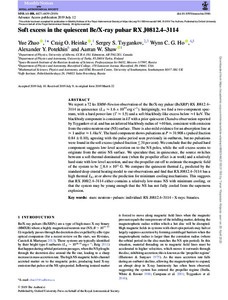Soft excess in the quiescent Be/X-ray pulsar RX J0812.4-3114
Shaw AW; Ho WCG; Zhao Y; Heinke CO; Potekhin AY; Tsygankov SS
Soft excess in the quiescent Be/X-ray pulsar RX J0812.4-3114
Shaw AW
Ho WCG
Zhao Y
Heinke CO
Potekhin AY
Tsygankov SS
OXFORD UNIV PRESS
Julkaisun pysyvä osoite on:
https://urn.fi/URN:NBN:fi-fe2021042824181
https://urn.fi/URN:NBN:fi-fe2021042824181
Tiivistelmä
We report a 72 ks XMM-Newton observation of the Be/X-ray pulsar (BeXRP) RX J0812.4-3114 in quiescence (L-X approximate to 1.6 x 10(33) erg s(-1)). Intriguingly, we find a two-component spectrum, with a hard power-law (Gamma approximate to 1.5) and a soft blackbody-like excess below keV. The blackbody component is consistent in kT with a prior quiescent Chandra observation reported by Tsygankov et al. and has an inferred blackbody radius of;----10 km, consistent with emission from the entire neutron star (NS) surface. There is also mild evidence for an absorption line at approximate to and/or approximate to 1.4 keV. The hard component shows pulsations at P approximate to 31.908 s (pulsed fraction 0.84 +/- 0.10), agreeing with the pulse period seen previously in outbursts, but 110 pulsations were found in the soft excess (pulsed fraction less than or similar to 31 per cent). We conclude that the pulsed hard component suggests low-level accretion on to the NS poles, while the soft excess seems to originate from the entire NS surface. Wc speculate that, in quiescence, the source switches between a soft, thermal-dominated state (when the propeller effect is at work) and a relatively hard state with low-level accretion, and use the propeller cut-off to estimate the ma.gnetic field of the system to be less than or similar to 8.4 x 10(11)G. We compare the quiescent thermal L-X predicted by the standard deep crustal heating model to our observations and find that RX J0812.4-31.14 has a high thermal L-X, at or above the prediction for minimum cooling mechanisms. This suggests that RX J0812.4-3114 either contains a relatively low-mass NS with minimum cooling, or that the system may be young enough that the NS has not fully cooled from the supernova explosion.
Kokoelmat
- Rinnakkaistallenteet [19250]
